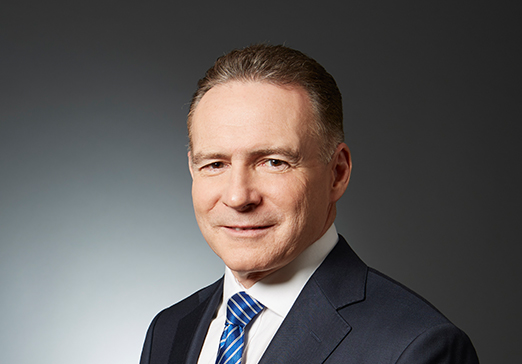Q4 2024 Strategy & Market Reviews
Each quarter, our Investment Management teams publish their key observations and portfolio updates across Global Equity and Fixed Income markets. This is a summary of our views for the Fourth Quarter of 2024. You can download the full reports via the links shown below.
KEY OBSERVATIONS
Markets moved higher heading into year-end with the help of a decent earnings print for the third quarter and a decisive victory for Donald Trump. During the fourth quarter, the S&P500 total return was +2.41% in US dollars. Adjusting for currency, the S&P500 returned +9.10% in Canadian dollars, as the Canadian dollar depreciated about 4.42 cents. The TSX total return was +3.76%.
While the Federal Reserve lowered interest rates for the third time in December, it surprised markets with a relatively hawkish outlook in its Summary of Economic Projections, removing two interest rate cuts in 2025 from its September projection of four cuts. However, just two days after the Fed meeting, the Fed’s preferred inflation measure came in lower than expected. While the data may be choppy, our bias is to accept that rates will likely continue lower in 2025, just not at the same pace seen in late 2024.
The US economy is performing well, even with higher rates. In Canada, October’s latest read on real GDP was better than expected, coming in at a 1.9% annualized rate. Meanwhile, third quarter US earnings growth was 5.9%, exceeding estimates of 4.2%, and fourth quarter earnings growth estimates of 11.9% are the highest they have been in three years, exceeding the 10-year average of 8.5%. These figures are all significant, as economic growth drives earnings growth, and investors’ expectations for both tend to drive share valuations.
There are a lot of “known unknowns” regarding fiscal policy under Trump 2.0 that could impact the market. Both tax cuts and tariffs could put upward pressure on inflation unless they are offset by a stronger US dollar. On the other hand, deregulation, reductions in government spending, and higher US energy production could be disinflationary. It’s useful to remember that, historically, the S&P 500 has continued to move higher over time, regardless of whether it is the Republicans or Democrats in the White house (or Mar-a-Lago).
In assessing our thoughts for 2025, we like to take a systematic, data-driven approach. This is what’s kept us in the market during the past two years despite broad-based investor concerns over Fed policy, economic growth, and “Mag 7”-dominated returns. While the year ahead will not be without its challenges, the outlook for inflation, interest rates, economic growth and earnings remains constructive, and general expectations are that Trump 2.0 should be supportive of economic growth. Within that context, we remain optimistic.
NORTH AMERICAN EQUITY UPDATE

Peter Jackson, HBSc, MBA, CFA
Chief Investment Officer
Portfolio Manager, North American Equities
Our overall equity exposure decreased 1% to 96% and cash increased from 3% to 4% since September 30th, 2024. Our US equity exposure increased to 57%, up from 55%, on September 30th, while our Canadian equity exposure declined to 39% from 42%.
Compared to a year ago, our exposure in Canada has declined 9%, while our US exposure has increased 10%. It is important to note that many of our clients’ portfolios are invested in our North American plus International Equity strategy, meaning that the actual weights of US and Canada within their equity holdings will be proportionately less than this given the allocation to international companies.
Over the past 12 months, we continued to shift our allocation in favour of US equities over Canadian equities and remained fully invested in equity to the extent that clients’ individual limits allow.
The US economy and earnings growth for the S&P500 continued to outpace the Canadian economy and earnings growth for the TSX so far in 2024, and this is estimated to continue in 2025 and 2026.
Having said that, interest rates are declining faster here in Canada than in the US, which may mitigate the risk of a slowdown in Canada, as the Bank of Canada is clearly focused on trying to accelerate growth in 2025. It is worth noting that our Canadian companies have growing earnings, and many are globally diversified in terms of revenue sources despite having a Canadian headquarters.
We did not initiate any new stock positions during the quarter.
GLOBAL EQUITY UPDATE

Phil D’Iorio, MBA, CFA
Portfolio Manager, Global Equities
The end of 2024 marked another year of solid returns for global equity markets. The S&P 500 rose 25% on a total return basis, following a 26.3% increase in 2023. The last time this benchmark index generated two consecutive years of 20%+ returns was in 1998. Outside of the US, the Tokyo Stock Exchange generated a total return of just over 20%, while the Euro Stoxx 600 index delivered a total return of nearly 10%.
The leadership of US stocks was driven by a resilient economy and strong corporate earnings. The US consumer is in good shape, with the effective interest rate on mortgage debt at just 4% and the debt-to-disposable income ratio declining. The US economy is also being supported by trends such as reshoring, electrification, and artificial intelligence, as well as stimulative fiscal policies including the CHIPS Act, Inflation Reduction Act, and JOBS Act.
The European economy is not enjoying the same tailwinds as the US economy. High energy prices, ongoing struggles in the region’s largest economy (Germany), and the knock-down impact of the weakness in China are some of the key factors that weigh on Europe’s economy. We expect there will continue to be a wide divergence in the economic prospects between Europe and the United States for some time.
In terms of risks, we would highlight tariffs, immigrant deportation, and a resurgence in inflation. If enacted, Trump’s tariff proposals would push the effective tariff rate up roughly sevenfold to 21%, according to analysts at Fitch Ratings. Further, a crackdown on undocumented immigrants could create a significant shock to the U.S. labor market. Taken together, tariffs and immigrant deportation have the potential to reignite inflation.
At the end of the day, we believe cooler heads will prevail. Donald Trump has surrounded himself with a team of market-savvy individuals, and he prides himself on a strong economy and market. It seems unlikely that he would pursue an agenda that would jeopardize all of the good things that are currently happening in the economy and the stock market.
We have a cautiously optimistic view for the global economy overall. According to the OECD, there are more countries that are expected to experience accelerating economic growth than decelerating growth in 2025, and not a single major economy is expected to fall into recession.
In our Global strategy, we established the follow new positions during the quarter:
Booz Allen Hamilton Holding Corporation provides civil and military government services to the federal government. Booz Allen has historically outgrown its peers by 2% to 4% per year and has delivered mid-to- high single-digit organic revenue growth. The company also uses M&A to accelerate growth and to bring new capabilities to the firm. Booz Allen is a very cash generative business and the company has a strong track record of efficient capital allocation.
Eli Lilly is the largest pharmaceutical company in the United States, with leading positions addressing diabetes, obesity, and recently Alzheimer’s disease. We believe its innovative therapies have the potential to improve millions of lives while also driving significant value for investors in the years to come.
In the International strategy, we initiated three new positions:
BAE Systems is one of the world’s largest aerospace and defence companies, spanning all domains of the global security market, from air and space, to land, sea and cyber domains. The company’s backlog is at record levels, with many NATO countries now raising their spending commitments. The company has demonstrated a strong track record of growth, and it maintains a strong balance sheet supporting capital return to shareholders including acquisitions, dividends, and share buybacks.
Deutsche Boerse is a diversified exchange operator that offers a large suite of products and services. The company is responsible for well-known stock market index-based products (STOXX® and DAX®) as well as ESG and governance research for institutional investors and companies. Deutsche Boerse is a very cash generative business and has been a strong allocator of capital over the years.
Diploma is a decentralised distributor operating globally across three main end markets including Controls, Seals, and Life Sciences. Diploma distinguishes itself in the distributor sector by providing a higher degree of advice and customisation. This added value allows Diploma to command higher margins, as clients are typically willing to pay a premium for the specialized services and bespoke solutions.
Experian is one of the largest information services companies in the world, and well-positioned to benefit from major structural tailwinds associated with the collection and use of consumer and business data. The company’s operating model is highly cash generative, which has enabled it to simultaneously invest in its core business, make acquisitions, and return cash to shareholders via dividends and share buybacks.
Trane Technologies is involved in the design, manufacture, sale and service of heating, ventilation and air-conditioning (HVAC), and transport refrigeration technologies. Trane separated from its parent company, Ingersoll Rand, in 2020, and operates under the two major brands of Trane (HVAC) and Thermo King (Transport Refrigeration). We believe that the company will benefit from key industrial megatrends including AI-driven proliferation of data centers, US reshoring, and the need for greater energy efficiency.
A detailed review of each company can be found in the full report per the link above.

Owen Morgan, MBA, CFA
Portfolio Manager, Fixed Income
Decreasing economic growth, rising unemployment and receding inflation lead the Bank of Canada to cut interest rates twice during the fourth quarter of 2024, by a “jumbo” 50 bps each time, to bring the overnight rate to 3.25%, the lowest it has measured since October 2022. While the market largely believes further cuts will follow in 2025, it also believes we are closer to the end of the rate cut cycle than the beginning.
The Canadian yield curve decreased and flattened over the course of 2024, and we ended the year with rates in the 3-3.5% range across all tenors, and mostly upward sloping. A large downward move in the 2-year note was driven by five cuts to the Bank of Canada’s overnight lending rate, totaling 175 bps. This decrease was a powerful driver for price appreciation in bonds and fixed income securities in 2024. In the fourth quarter, the 2-year note remained relatively unchanged, while the 5-year and 10-year rates increased modestly.
Readers of previous updates will be familiar with another driver of fixed income returns, namely credit spreads. This is the additional yield provided by corporate bonds over government bonds. Spreads tightened throughout 2024, including in the fourth quarter. This tightening was driven by decreasing market-wide fears of financial stress, and therefore increasing comfort with corporate risk.
These two factors together – the move lower in rates, and the tightening of credit spreads – generated a positive year for investors, particularly for corporate bonds.
We believe the outlook for fixed income is generally positive, absent any unforeseen credit shocks. We believe we are in the later innings of an interest rate cut cycle by the Bank of Canada, however there is still some uncertainty related to the total number of cuts, the timing and the magnitude. We think that the yield curve will continue to normalize, and do not expect corporate spreads to widen materially.
In terms of the Cumberland Income Fund portfolio positioning, we anticipate maintaining, if not extending, the fund’s duration given our view on near-term interest rate movements. As rates decrease, our bond valuations should appreciate. In addition, as we believe corporate spreads are unlikely to widen to a significant degree, we will continue to maintain our exposures to corporate credit, as well as certain non-investment-grade credits that we identify as having attractive risk-return profiles.



